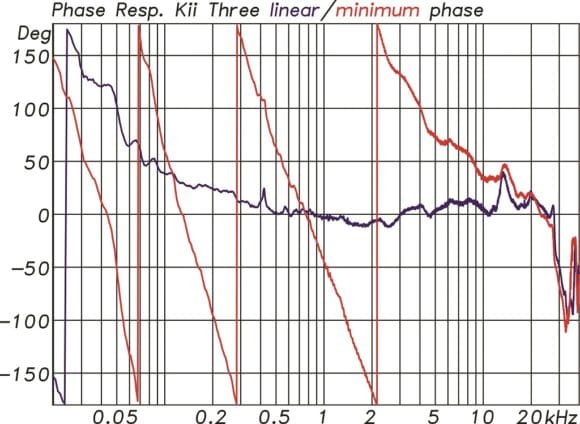Dear All,
Long time reader, since I own 5x Genelec 8351B (combined with 2x SVS PC 13 Ultra subwoofers) and a Trinnov, I felt to chime in and maybe can answer some questions.
The Genelecs replaced a Magnepan MG20.7 and MG1.7 with 5x Benchmark AHB2 (bridged mode) surround set-up.
I am aware my center speaker isn't placed "ideally," and I would wish for the surround channels to be placed lower and closer to ear height. However, in my compromised rented apartment, there is a limit to what I can do. If I could live my dream, I had a fully acoustically treated dedicated surround room and follow the ITU standard.
That being said, In a fully concrete room, Thick high pole carpets and bookshelves helped tremendously reduce RT time to 0.31sec. And the Trinnov did an excellent job, flatten and corrected all channels.
The Trinnov indeed applies phase correction. Please see attached screenshot of the predicted post-correction response.
Stand alone with GLM, the 8351B is a terrific speaker, and because it does so much "right," there is little "wrong. It isn't everyone's cup of tea. My girlfriend, for one, says it is at times to "overwhelming" and not for background listening. So many details get thrown into your face, according to her. For me, this is the ultimate dream and what I have craved for a lifetime.
With a pro-audio background, I love to be able (and finally can with the Genelecs) to hear the layers of different synthesizers. For example, on multiple Quincy Jones albums, I can finally distinguish which synths are layered together for a particular sound layer. For example, a Roland MKS20 with a Roland D50 to create a new sound. I can hear mix decisions and even the slightest variation in panning.
I would swear I can even recognize the Lexicon 480L reverb as a layer separated from the vocal. They are THAT revealing.
I have read some concerns about the headroom. It is a small speaker with relatively small woofers. However, I never encountered any strain, distortion, or clipping. This is probable is because I use a steep 8th order (L/R) cross-over between mains and subs, which removes the strain from the 8351B's woofers.
The Trinnov lifts an already excellent designed speaker one level up. I have had the Trinnov corrected aggressively, as can be seen in the settings below:
• Resolution of Energy Response: 1/24 octave for IIR & FIR
• Number of IIR filters 50
• IIR filters maximum Frequency 200
• FIR filter length 300ms
• Cross-over 80Hz L/R 8th order
What happens is that every sound is placed in space, and you don't hear speakers anymore. With choirs, each singer is set in-depth, while all other instruments and vocals are placed in front. At first, I even had to get used to it and wondered if I pushed things too far, But it is delightful.
Thanks!





